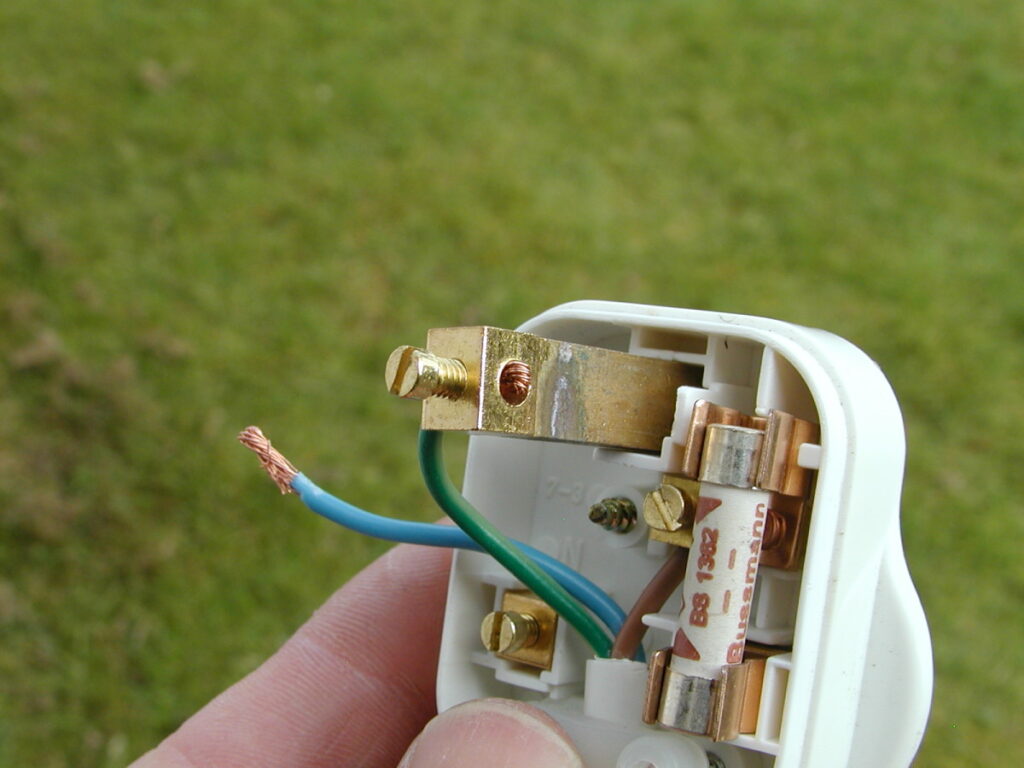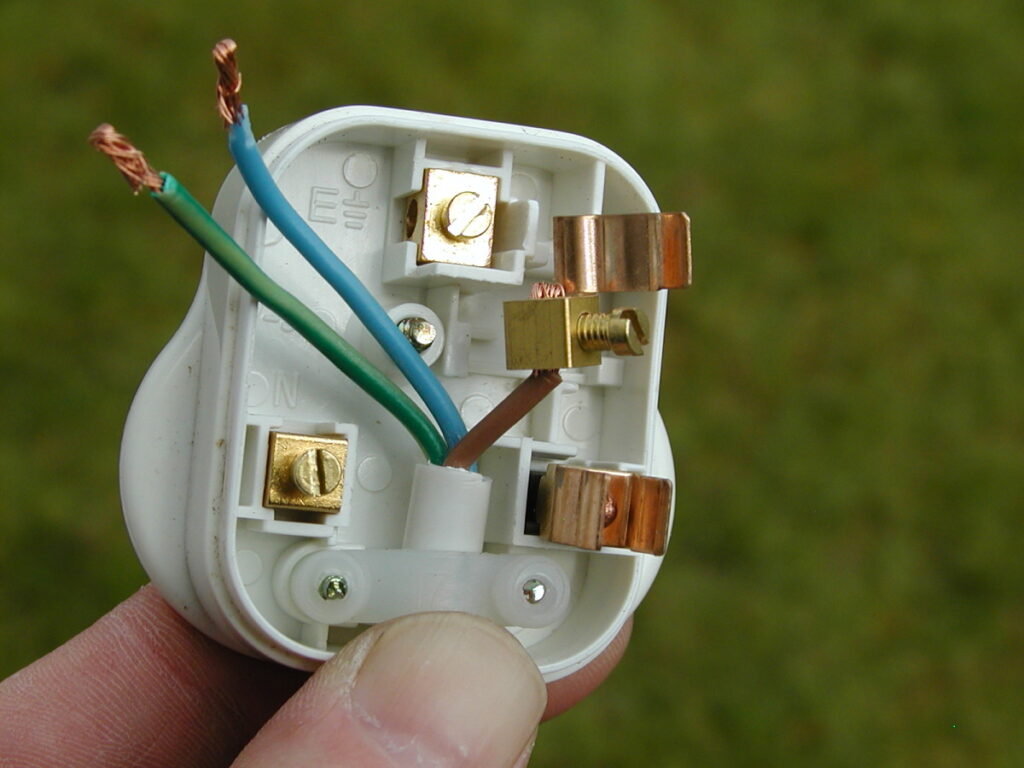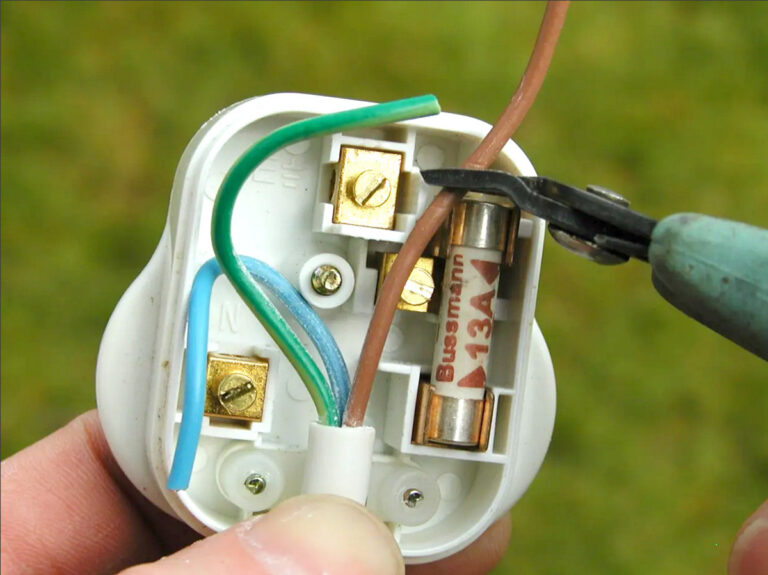A plug needs both a live and neutral wire to make electricity flow safely and effectively. The live wire brings electricity from the power source to the device, providing the energy needed for it to work.
In addition, the neutral wire then completes the circuit, allowing the electricity to return to the power source. Together, these wires ensure a continuous and balanced flow of electricity, making our appliances function properly while minimizing the risk of electrical shocks.
Live Wires
Live wires are like power highways in your home. They carry electricity from the main electrical box to different places, like switches, outlets, or light fixtures. Think of them as the “hot” wires because they have a lot of power.
No matter where the live wire goes, it’s always full of electricity. It’s like a constant flow of power from the main electrical box to wherever it’s needed.
Neutral Wires

Now, for everything to work smoothly, the electricity needs to complete a journey. This is where neutral wires come in. They guide the electricity back to the main electrical box, completing the trip.
Once the electricity has done its job (like lighting up a room), the neutral wire brings it back home. This helps keep things safe and in balance.
Remember, just like live wires, neutral wires can have electricity in them when they’re in use. It’s a good idea to be careful and think of them as always carrying a little charge. Safety first!
Purpose of Neutral Wire
The neutral wire serves a crucial purpose in electrical systems:
- Completing the Circuit:
- The neutral wire completes the electrical circuit by providing a return path for the current to flow back to the power source.
- Balancing the Load:
- It helps balance the electrical load in a circuit, ensuring that the voltage remains stable and preventing potential issues like overloading.
- Returning Current Safely:
- After the live wire delivers electrical power to the appliance, it can safely carry the used current back to the power source.
- Grounding Reference:
- It is often connected to the ground at the main electrical panel, serving as a reference point for the electrical system.
- Safety and Prevention of Shocks:
- In the absence of it, the electrical circuit would be incomplete, posing a risk of electric shocks and potentially damaging appliances.
- Compliance with Electrical Codes:
- Adherence to electrical codes and standards typically requires the presence of it in wiring systems to ensure safe and standardized installations.
Purpose of Live Wire
The live wire, often referred to as the “hot” wire, serves several crucial purposes in an electrical system:
- Carrying Electrical Current:
- The primary purpose of it to carry electrical current from the power source (such as an electrical outlet or socket) to the electrical device or appliance.
- The current provided by the live wire supplies the energy necessary for the proper functioning of the connected device.
- Voltage Supply:
- It carries an alternating current (AC) that alternates direction periodically. This alternating voltage provides the energy needed to power electrical devices.
- The voltage on the live wire varies based on the region and electrical standards but is typically within a specified range suitable for the operation of common appliances.
- Initiating Electrical Work:
- In many electrical devices, it is the one that initiates the work or function of the device. For example, a light bulb, supplies the current that generates light.
- Color Coding:
- Live ones are often color-coded to distinguish them from neutral and ground wires. In many regions, they are coded with colors such as brown or black.
- Safety Features:
- The live wire is designed to be well-insulated to prevent accidental contact and minimize the risk of electrical shocks. Adequate insulation ensures that the current flows through the intended path.
- Switching and Control:
- In some electrical systems, it may be interrupted by switches or other control devices. This allows users to turn devices on and off, controlling the flow of electricity to the connected appliance.
- Compatibility with Appliances:
- Different electrical devices have specific voltage and current requirements for proper operation. It is responsible for supplying the correct voltage to meet the needs of the connected device.
Safety Considerations
Safety considerations are paramount when working with electrical systems, including the use of live and neutral wires in plugs. Here are key safety considerations:
- Electrical Shocks:
- Live wires carry electrical current and pose a risk of electric shock if touched or if there is faulty insulation. Proper insulation and the use of appropriate materials are essential to prevent direct contact.
- Proper Insulation:
- Insulation on live ones must be intact to prevent short circuits and ensure that the current flows safely within the designated conductive path. Damaged insulation should be repaired or replaced promptly.
- Grounding:
- Grounding is an additional safety measure. It provides an alternative path for electrical current in the event of a fault, directing it safely into the ground and preventing the risk of electric shock.
- Polarization:
- Polarized plugs have one prong wider than the other, ensuring that the live and neutral ones are connected correctly. Using polarized plugs correctly reduces the risk of electrical shock and equipment damage.
- Residual Current Devices (RCDs):
- RCDs, also known as ground fault circuit interrupters (GFCIs), are safety devices designed to quickly disconnect power in the event of a ground fault. They provide an added layer of protection against electric shock.
- Adherence to Electrical Codes:
- Compliance with electrical codes and regulations is crucial for safety. These codes are established to ensure proper installation, use of suitable materials, and adherence to safety standards.
- Avoiding Overloading Circuits:
- Overloading circuits can lead to overheating and electrical fires. Use the appropriate circuit breakers, fuses, and ensure that the electrical load on a circuit does not exceed its capacity.
- Professional Installation:
- Electrical work, including the installation of plugs and wiring, should ideally be performed by licensed and qualified electricians. Professional installation ensures that safety standards are met.
- Regular Inspections:
- Periodic inspections of electrical systems, plugs, and wiring can identify potential issues before they become hazards. Look for signs of wear, damage, or overheating.
- Educational Awareness:
- Users should be aware of basic electrical safety practices. This includes not overloading outlets, avoiding the use of damaged plugs or cords, and understanding how to use electrical devices safely.
- Emergency Preparedness:
- Know the location of circuit breakers and how to shut off power in case of an emergency. Have fire extinguishers accessible and know how to use them for electrical fires.
The functionality of Appliances
Let’s talk about how appliances work and why live and neutral wires are essential for their functionality.
**1. Getting Power:
- Appliances, like your toaster or TV, need power to work. The live wire brings electricity from the main power source to the appliance.
**2. Using the Power:
- Once the live wire delivers electricity to the appliance, it powers up the device. For example, the live wire in your blender makes the blades spin or in your computer makes it turn on.
**3. Completing the Circuit:
- Every electrical device needs a full loop to work correctly. This is where the neutral wire comes in. It carries the used electricity back to the main power source, completing the circuit.
**4. Balancing Act:
- The live and neutral wires work together to make sure the right amount of electricity goes to the appliance and then safely comes back. It’s like a teamwork—live wire brings the power, and neutral wire takes it back.
**5. Safety First:
- Appliances are designed to work with a specific amount of power. The live and neutral wires help provide the right voltage for each device, keeping things safe and preventing electrical issues.
**6. Switching On and Off:
- Sometimes you want to use an appliance, and sometimes you don’t. The live wire is often controlled by switches, so when you turn off a device, it breaks the connection, stopping the flow of electricity.
**7. Different Appliances, Different Needs:
- Every appliance has its own requirements for how much power it needs. The live and neutral wires ensure that each device gets the right amount of electricity to function correctly.
Common Alternatives and Variations

- Two-Prong vs. Three-Prong Plugs:
- Two-prong plugs have two wires – live and neutral. They are common in older homes. Three-prong plugs add a grounding wire for added safety, reducing the risk of electric shock.
- Polarized Plugs:
- Some plugs have one prong wider than the other, ensuring proper orientation. This helps maintain consistency in connecting live and neutral wires and enhances safety.
- Ground Fault Circuit Interrupters (GFCIs):
- GFCIs are specialized outlets designed to quickly cut off power if they detect a ground fault, preventing electrical shocks. They are commonly used in areas where water is present.
- Arc Fault Circuit Interrupters (AFCIs):
- AFCIs detect dangerous arcing conditions in electrical circuits, reducing the risk of electrical fires. They are often required in bedrooms and other living spaces.
- Smart Plugs:
- Smart plugs incorporate technology for remote control, scheduling, and energy monitoring. They may have additional features but still follow the basic principles of live and neutral wires.
- International Plug Standards:
- Different regions may have unique plug designs and standards. Understanding these variations is crucial for compatibility when traveling or using international appliances.
Troubleshooting Issues
- No Power to Appliance:
- Check if the appliance is plugged in.
- Ensure the circuit breaker or fuse for that outlet is not tripped or blown.
- Tripped Circuit Breaker:
- If a circuit breaker keeps tripping, it may indicate an overload. Unplug devices on that circuit and reset the breaker.
- Outlet Hot to Touch:
- A hot outlet may indicate an overloaded circuit or a faulty connection. Unplug devices, and consult an electrician if the issue persists.
- Flickering Lights or Dimming:
- This may be due to voltage fluctuations or poor connections. Contact an electrician to assess and fix the issue.
- Burning Smell or Sparks:
- Turn off power immediately and do not use the outlet. Contact an electrician to inspect and repair the wiring.
- GFCI Tripping:
- If a GFCI outlet keeps tripping, it may indicate a ground fault. Check for faulty appliances or wiring and consult a professional.
- Appliance Malfunction:
- If an appliance is not working correctly, check its plug, cord, and the outlet. Replace damaged components, and if the issue persists, consult the manufacturer or a technician.
- Intermittent Power Loss:
- Intermittent power loss may be due to loose connections. Ensure all wires are securely connected, and if the problem persists, seek professional assistance.
FAQ’s
1. Why do we use live and neutral wire?
Live wires carry current to appliances, while neutral wires return the current to the source, completing the circuit for safe and efficient electricity flow.
2. What is the function of the live wire in a plug?
Live wires in a plug carry power from the source to switches or appliances, meeting the electrical demand at various locations in your home.
3. Do you need a neutral wire for a plug?
Yes, a neutral wire is essential for a plug to complete the electrical circuit. Without it, the electricity wouldn’t flow properly and may violate wiring regulations.
4. Why does a light need a neutral wire?
A neutral wire allows smart light switches to stay connected to home Wi-Fi even when the switch is off, ensuring continuous power flow for smart functionalities.
5. What happens if live and neutral wires touch?
If live and neutral wires touch, it can lead to insulation damage or a fault in the appliance, causing a short circuit and an abrupt increase in current.
6. What happens if earth and neutral wires touch?
If earth and neutral wires touch, it can create a ground loop, causing both to carry equal magnitudes of current and potentially leading to electrical issues.
7. Which is live and neutral on a plug socket?
The plug has markings inside to identify each pin: (L) for Live (Brown), (N) for Neutral (Blue), and (E) for Earth (Yellow & Green).
8. What happens if live and neutral are reversed?
If live and neutral are reversed, it can lead to electrical issues and pose a safety risk, potentially causing shocks even when the switch is off during maintenance.
Final Words
In conclusion, the necessity of both live and neutral wires in a plug is fundamental for the safe and efficient operation of electrical devices. The live wire brings the essential electricity from the power source to power the device, while the neutral wire completes the circuit, enabling the electricity to return safely.
Moreover, this balanced and controlled flow of electrical current not only ensures the proper functioning of appliances but also plays a crucial role in preventing electrical hazards. The combination of live and neutral wires in a plug is a fundamental aspect of electrical safety standards, providing a reliable and standardized approach to power distribution in homes and buildings.

